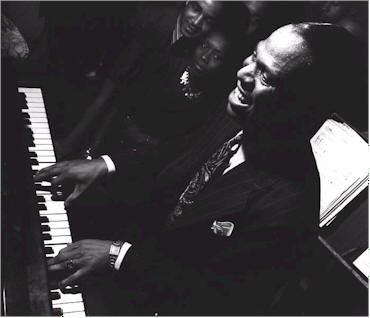Good luck brought Earl Hines and Louis Armstrong together in 1926 when they met by accident at the local musician's union hall in Chicago. The two soon-to-be jazz legends became great friends, and Hines worked briefly in Louis Armstrong's Stompers. Their friendship resulted in a series of spectacular recordings made in 1928, including the famous Hot Five and Hot Seven sessions that produced "West End Blues," "Fireworks," and "Basin Street Blues."
BONUS CONTENT Earl Hines interview.
It was 1928 when everything fell into place for Hines. In addition to the sessions with Armstrong, he recorded his first ten piano solos, including versions of "A Monday Date," "Blues in Thirds" and "57 Varieties."
On the night of his 25th birthday on December 28, 1928 Earl Hines opened at the glitzy Grand Terrace Ballroom in Chicago, leading his own ten-piece orchestra. Coast-to-coast live radio broadcasts from the Grand Terrace soon made Earl Hines a household name in America.
Earl Hines would continue to lead his own big bands for 20 years. He featured future jazz stars, such as singers Billy Eckstine and Sarah Vaughan, and bop pioneers Dizzy Gillespie and Charlie Parker.
This week on Riverwalk Jazz we celebrate Hines' musical legacy with live performances by our special guests Dick Hyman and John Sheridan. Broadway actor Vernel Bagneris brings to life Hines' reminiscences as collected by jazz writer Stanley Dance.
In 1964 Earl Hines staged a major comeback. Jim Cullum recorded Hines for his Audiophile label in 1971. "We did it at the home of legendary recording engineer Ewing P. Nunn in Milwaukee. Hines recorded solo piano material for three LPs over the course of one and a half days. Of all the tunes we recorded, only one had to be re-done; the rest were captured in the first take."
Earl Hines died at the age of 79 in 1983 in Oakland, CA.
Photo credit for Home Page: Earl Hines on piano with Jack Teagarden on trombone. Photo courtesy avalonjazz.blogspot.
Based on Riverwalk Jazz script by Margaret Moos Pick ©2003



